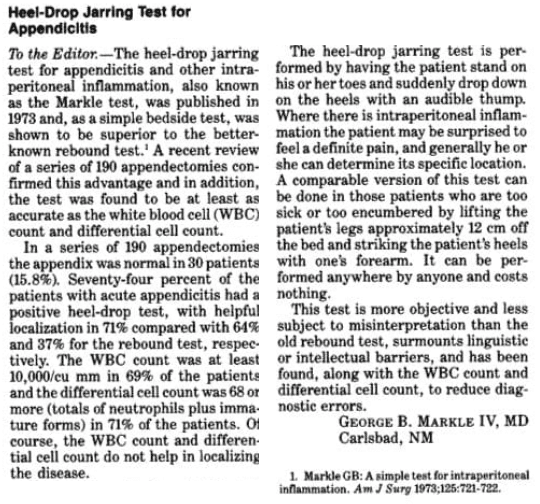Markle Sign
Description
The Markle Sign, Markle Test or Heel Drop Jarring Test is elicited in patients with intraperitoneal inflammation by having a patient stand on his or her toes and suddenly dropping down onto the heels with an audible thump.
If abdominal pain is localised as the heels strike the ground, Markle Sign is positive. If the pain is localised to the right lower quadrant, this is suggestive of acute appendicitis.
In 1973, George Bushar Markle IV (1921-1999) described the test he performed on patients in whom he attempted to localize or rule out the presence of intraperitoneal inflammation. His simple test is performed in the following manner:
The patient is asked to stand knees straight, with or without shoes. The clinician faces him and asks the patient to do as he does. The clinician stands on his toes for a few seconds and, relaxing suddenly, comes down with his full weight upon his heels with a definite thump. The unsuspecting patient does likewise and may be quite surprised to feel a definite pain wherever there is inflammation in the abdomen. Not only can he tell you, usually quite positively, if there is pain, but also he can tell just where the pain is most severe. In the wary patient who bends the knees or who comes down on the heels too gently, it may be necessary to repeat the test with admonitions to the patient not to restrain his short drop
Markle 1973
Clinical Validation
In 1985 Markle published a series of 190 appendectomies, 74% of the patients with acute appendicitis had a positive Markle Sign, with 71% identifying the precise localization of the inflammation. The Markle Sign was shown to be superior to the better known ‘rebound test’ and at least as accurate as the white blood cell count as a diagnostic marker in acute appendicitis.

In 2010 Menteş et al evaluated 430 patients with acute abdominal pain and correlated to histological examination of the appendix at operation. They found that the Markle sign had a sensitivity of 85% and specificity of 30%. However a positive Markle sign (heel drop test) AND a WBC > 11.950/mm³; AND presence of pain in the right lower quadrant increased the probability of having appendicitis by 9.75-fold (PPV 96%)
Ahn et al compared the Markle test with rebound tenderness and found the Markle sign had sensitivity of 69% and specificity of 65% in the diagnosis of acute appendicitis, higher than any other marker evaluated in isolation.
Associated Persons
- George Bushar Markle IV (1921 – 1999)
References
Original articles
- Markle GB. A simple test for intraperitoneal inflammation. The American Journal of Surgery. 1973; 125(6): 721-722
- Markle GB. Heel-Drop Jarring Test for Appendicitis. Arch Surg. 1985; 120(2): 243.
Review articles
- Menteş O et al. The Importance of Heel Drop Physical Examination Sign in Diagnosis of Acute Appendicitis. Eur J Surg Sci 2010; 1(3): 77-82
- Ahn S et al. Clinical Importance of the Heel Drop Test and a New Clinical Score for Adult Appendicitis. PLoS One. 2016; 11(10): e0164574
- McKennedy C. Markle Test. Eponym A Day. Instagram
- Eponymythology: Appendicitis eponymous signs. LITFL
[cite]
Dr Michael Leith, Emergency Doctor at a tertiary hospital in Perth, Western Australia | LinkedIn |
